Royal Australian Navy
| Royal Australian Navy | |
|---|---|
 | |
| Founded | 1 March 1901 |
| Country | |
| Branch | Navy |
| Role | Naval warfare |
| Size |
|
| Part of | Australian Defence Force |
| Headquarters | Russell Offices, Canberra |
| Motto(s) | To fight and win at sea.[2] |
| March | "Royal Australian Navy" |
| Anniversaries | 10 July |
| Fleet | |
| Engagements | |
| Website | www |
| Commanders | |
| Chief of the Defence Force | Admiral David Johnston |
| Vice Chief of the Defence Force | Air Marshal Robert Chipman |
| Chief of Navy | Vice Admiral Mark Hammond |
| Deputy Chief of Navy | Rear Admiral Jonathan Earley |
| Commander Australian Fleet | Rear Admiral Christopher Smith |
| Insignia | |
| Naval ensign |  |
| Naval jack |  |
| King's Colours |  |
| Aircraft flown | |
| Multirole helicopter | MH-60R Seahawk |
| Trainer helicopter | EC-135T2+ |
The Royal Australian Navy (RAN) is the naval branch of the Australian Defence Force (ADF). The professional head of the RAN is Chief of Navy (CN)[3] Vice Admiral Mark Hammond AM, RAN. The Chief of Navy is also jointly responsible to the Minister for Defence (MINDEF) and the Chief of the Defence Force (CDF). The Department of Defence, which is a part of the Australian Public Service, administers the ADF, and ergo, the Royal Australian Navy.[4] In 2023, the Surface Fleet Review was introduced to outline the future of the Navy.
The navy was formed in 1901 as the Commonwealth Naval Forces (CNF) through the amalgamation of the colonial navies of Australia following the federation of Australia. Although it was originally intended for local defence, it became increasingly responsible for regional defence as the British Empire started to diminish its influence in the South Pacific.
The Royal Australian Navy was initially a green-water navy, as the Royal Navy provided a blue-water force to the Australian Squadron, which the Australian and New Zealand governments helped to fund; the squadron was assigned to the Australia Station. This period lasted until 1913, when naval ships purchased from Britain arrived, although the British Admiralty continued to provide blue-water defence capability in the Pacific and Indian Oceans up to the early years of the Second World War.[5]
During its history, the Royal Australian Navy has participated in a number of major wars, including the First and Second World Wars, Korean War, Malayan Emergency, Indonesia-Malaysia Confrontation and the Vietnam War. As of 2024, the RAN consists of over 52 commissioned vessels, 11 non-commissioned vessels and over 16,000 personnel. The navy is one of the largest and most sophisticated naval forces in the South Pacific region, with a significant presence in the Indian Ocean and worldwide operations in support of military campaigns and peacekeeping missions.
History
[edit]Formation
[edit]The Commonwealth Naval Forces were established on 1 March 1901, with the amalgamation of the six separate colonial naval forces, following the Federation of Australia.[6] The Royal Australian Navy initially consisted of the former New South Wales, Victorian, Queensland, Western Australian, South Australian and Tasmanian ships and resources of their disbanded navies.
The Defence Act 1903 established the operation and command structure of the Royal Australian Navy.[7] When policymakers sought to determine the newly established force's requirements and purpose, there were arguments about whether Australia's naval force would be structured mainly for local defence or designed to serve as a fleet unit within a larger imperial force, controlled centrally by the British Admiralty.[8] In 1908–09, a compromise solution was pursued, with the Australian government agreeing to establish a force for local defence but that would be capable of forming a fleet unit within the Royal Navy, albeit without central control. As a result, the navy's force structure was set at "one battlecruiser, three light cruisers, six destroyers and three submarines". The first of the RAN's new vessels, the destroyer HMAS Yarra, was completed in September 1910, and by the outbreak of the First World War the majority of the planned fleet had been realised.[9] On 10 July 1911, the CNF was granted "Royal" status by King George V.[10]
World War I
[edit]Pacific
[edit]Following the British Empire's declaration of war on Germany, the British War Office tasked the capture of German New Guinea to the Australian Government. This was to deprive the Imperial German Navy's East Asia Squadron of regional intelligence by removing their access to wireless stations. On 11 August, three destroyers and HMAS Sydney prepared to engage the squadron at German Anchorages in New Guinea, which did not eventuate as the vessels were not present. Landing parties were placed on Rabaul and Herbertshohe to destroy its German wireless station; however, the objective was found to be further inland and an expeditionary force was required. Meanwhile, HMAS Australia was tasked with scouring the Pacific Ocean for the German squadron.
The Australian Naval and Military Expeditionary Force (ANMEF) began recruiting on the same day that the taskforce arrived in New Britain, and consisted of two battalions: one of 1,000 men, and the other with 500 serving and former seamen. On 19 August, the ANMEF departed Sydney for training in Townsville before the rendezvous with other RAN vessels in Port Moresby.[11] On 29 August, four cruisers and HMAS Australia assisted New Zealand's Samoa Expeditionary Force in landing at Apia, and committing a bloodless takeover of German Samoa. Additionally, the RAN captured German merchant vessels, disrupting German merchant shipping in the Pacific. On 7 September, the ANMEF, now including HMAS Australia, three destroyers, and two each of cruisers and submarines, departed for Rabaul.
A few days later, on 9 September, HMAS Melbourne landed a party to destroy the island's wireless station, though the German administration promptly surrendered. Between 11 and 12 September, landings were put ashore at Kabakaul, Rabaul and Herbertshohe; it was during this period that the first Australian casualties and deaths of the war occurred. On 14 September, HMAS Encounter barraged an enemy position at Toma with shells; it was the first time the RAN had fired upon an enemy and had shelled an inland location. On 17 September, German New Guinea surrendered to the encroaching ANMEF, with the overall campaign a success and exceeded the objectives set by the War Office. However, the RAN submarine HMAS AE1 became the first ever vessel of the new navy to be sunk.[11] The Australian Squadron was placed under control of the British Admiralty,[12] and was moreover tasked with protecting Australian shipping.[11]
On 1 November, the RAN escorted the First Australian Imperial Force convoy from Albany, WA and set for the Khedivate of Egypt, which was soon to become the Sultanate of Egypt. On 9 November, HMAS Sydney began hunting for SMS Emden, a troublesome German coastal raider. The SMS Emden and HMAS Sydney met in the Battle of Cocos, the Emden was destroyed in Australia's first naval victory. Following the almost complete destruction of the East Asia Squadron in the Battle of the Falklands by the Royal Navy, the RAN became able to be reassigned to other naval theatres of the war.[11]
Atlantic and Mediterranean
[edit]On 28 February 1915, the Royal Australian Naval Bridging Train (RANBT) was formed with members of the Royal Australian Naval Reserve who could not find billets in the RAN.[13] Following the entrance of the Ottoman Empire in alliance with the Central Powers, HMAS AE2 was committed to the initial naval operation of the Gallipoli campaign. After the failure of the naval strategy, an amphibious assault was planned to enable the Allies' warships to pass through the Dardanelles and capture Constantinople. The RANBT was sent ashore, along with the invasion, for engineering duties.[14]
Later in the war, most of the RAN's major ships operated as part of Royal Navy forces in the Mediterranean and North Seas, and then later in the Adriatic, and then the Black Sea following the surrender of the Ottoman Empire.[9]
Interwar years
[edit]In 1919, the RAN received a force of six destroyers, three sloops and six submarines from the Royal Navy,[15] but throughout the 1920s and early 1930s, the RAN was drastically reduced in size due to a variety of factors including political apathy and economic hardship as a result of the Great Depression.[16] In this time the focus of Australia's naval policy shifted from defence against invasion to trade protection,[17] and several fleet units were sunk as targets or scrapped. By 1923, the size of the navy had fallen to eight vessels,[16] and by the end of the decade it had fallen further to five, with just 3,500 personnel.[17] In the late 1930s, as international tensions increased, the RAN was modernised and expanded, with the service receiving primacy of funding over the Army and Air Force during this time as Australia began to prepare for war.[17]
World War II
[edit]Early in the Second World War, RAN ships again operated as part of Royal Navy formations, many serving with distinction in the Mediterranean, the Red Sea, the Persian Gulf, the Indian Ocean, and off the West African coast.[18] Following the outbreak of the Pacific War and the virtual destruction of Allied naval forces in Southeast Asia, the RAN operated more independently, defending against Axis naval activity in Australian waters, or participating in United States Navy offensives. As the navy took on an even greater role, it was expanded significantly and at its height the RAN was the fourth-largest navy in the world, with 39,650 personnel operating 337 warships, but no active submarines.[17] A total of 34 vessels were lost during the war, including three cruisers and four destroyers.[19]
Post war to present
[edit]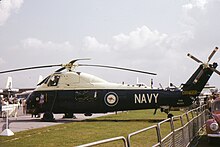
After the Second World War, the size of the RAN was again reduced, but it gained new capabilities with the acquisition of two aircraft carriers, Sydney and Melbourne.[20] The RAN saw action in many Cold War–era conflicts in the Asia-Pacific region and operated alongside the Royal Navy and United States Navy off Korea, Malaysia, and Vietnam.[21] Since the end of the Cold War, the RAN has been part of Coalition forces in the Persian Gulf and Indian Ocean, operating in support of Operation Slipper and undertaking counter piracy operations. It was also deployed in support of Australian peacekeeping operations in East Timor and the Solomon Islands.[22]
The high demand for personnel in the Second World War led to the establishment of the Women's Royal Australian Naval Service (WRANS) branch in 1942, where over 3,000 women served in shore-based positions. The WRANS was disbanded in 1947, but then re-established in 1951 during the Cold War. It was given permanent status in 1959, and the RAN was the final branch to integrate women in the Australian military in 1985.[23]
Structure
[edit]Command structure
[edit]The strategic command structure of the RAN was overhauled during the New Generation Navy changes.[24] The RAN is commanded through Naval Headquarters (NHQ) in Canberra.[25] NHQ is responsible for implementing policy decisions handed down from the Department of Defence and for overseeing tactical and operational issues that are the purview of the subordinate commands.[26]
Beneath NHQ are two subordinate commands:
- Fleet Command: fleet command is led by Commander Australian Fleet (COMAUSFLT). COMAUSFLT holds the rank of rear admiral; previously, this post was Flag Officer Commanding HM's Australian Fleet (FOCAF), created in 1911,[27] but the title was changed in 1988 to the Maritime Commander Australia. On 1 February 2007, the title changed again, becoming Commander Australian Fleet.[28] The nominated at-sea commander is Commodore Warfare (COMWAR), a one-star deployable task group commander. Fleet command has responsibility to CN for the full command of assigned assets, and to Joint Operations command for the provision of operationally ready forces.
- Navy Strategic Command: the administrative element overseeing the RAN's training, engineering and logistical support needs. Instituted in 2000, the Systems Commander was appointed at the rank of commodore; in June 2008, the position was upgraded to the rank of rear admiral.
Fleet Command was previously made up of seven Force Element Groups, but after the New Generation Navy changes, this was restructured into four Force Commands:[29]
- Fleet Air Arm (previously known as the Australian Navy Aviation Group), responsible for the navy's aviation assets and capability. As of 2018, the FAA consists of two front line helicopter squadrons (one focused on anti-submarine and anti-shipping warfare and the other a transport unit), two training squadrons and a trials squadron.[30]
- Mine Warfare, Clearance Diving, Hydrographic, Meteorological and Patrol Forces, an amalgamation of the previous Patrol Boat, Hydrographic, and Mine Warfare and Clearance Diving Forces, operating what are collectively termed the RAN's "minor war vessels"
- Submarine Force, (Royal Australian Navy Submarine Service) operating the Collins-class submarines
- Surface Force, covering the RAN's surface combatants (generally ships of frigate size or larger)
Fleet
[edit]The Royal Australian Navy consists of over 50 commissioned vessels and over 16,000 personnel.[31] Ships commissioned into the RAN are given the prefix HMAS (His/Her Majesty's Australian Ship).[32]
The RAN has two primary bases for its fleet: the first, Fleet Base East, is located at HMAS Kuttabul, Sydney and the second, Fleet Base West, is located at HMAS Stirling, near Perth.[33][34] In addition, three other bases are home to the majority of the RAN's minor war vessels: HMAS Cairns, in Cairns, HMAS Coonawarra, in Darwin, and HMAS Waterhen, in Sydney.[35][36][37]
Clearance Diving Branch
[edit]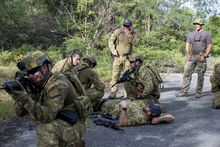
The Clearance Diving Branch is composed of two Clearance Diving Teams (CDT) that serve as parent units for naval clearance divers:
- Clearance Diving Team 1 (AUSCDT ONE), based at HMAS Waterhen in New South Wales; and
- Clearance Diving Team 4 (AUSCDT FOUR), based at HMAS Stirling in Western Australia.
When clearance divers are sent into combat, Clearance Diving Team Three (AUSCDT THREE) is formed.
The CDTs have two primary roles:
- Mine counter-measures (MCM) and explosive ordnance disposal (EOD); and
- Maritime tactical operations.
Personnel
[edit]
As of June 2023, the RAN has 14,745 permanent full-time personnel, 172 gap-year personnel, and 4,607 reserve personnel.[38] The permanent full-time trained force consists of 3,070 commissioned officers, and 9,695 enlisted personnel.[39] While male personnel made up 75.9% of the permanent full-time force, while female personnel made up 24%. The RAN has the second-highest percentage of women in the permanent forces, compared to the RAAF's 26.6% and the Army's 15.3%.[39] Throughout the 2022-23 financial year 1,141 enlisted in the RAN on a permanent basis while 1,354 left, representing a net loss of 213 personnel. [38]
The following are some of the current senior Royal Australian Navy officers:
- Vice Admiral David Johnston – Vice Chief of the Defence Force
- Vice Admiral Mark Hammond – Chief of Navy
- Vice Admiral Jonathan Mead – Chief Nuclear-Powered Submarine Taskforce
- Rear Admiral Jonathan Earley – Deputy Chief of Navy
- Rear Admiral Christopher Smith – Commander Australian Fleet
- Rear Admiral Matthew Buckley – Head Nuclear-Powered Submarine Capability
- Rear Admiral Stephen Hughes – Head Navy Capability
- Rear Admiral Rachel Durbin – Head Navy Engineering
- Rear Admiral David Greaves – Director-General Australian Navy Cadets
- Warrant Officer Andrew Bertoncin – Warrant Officer of the Navy
Ranks and uniforms
[edit]
Commissioned Officers
[edit]Commissioned officers of the Australian Navy have pay grades ranging from S-1 to O-10.[40] The highest rank achievable in the current Royal Australian Navy structure is O-10, an admiral who serves as the Chief of the Defence Force (CDF) when the position is held by a Naval Officer. The navy has a O-11 position Admiral of the Fleet that is honorary and is currently held by King Charles III.[40][41]
O-8 (rear admiral) to O-11 (admiral of the fleet) are referred to as flag officers, O-5 (commander) and above are referred to as senior officers, while S-1 (midshipman) to O-4 (lieutenant commander) are referred to as junior officers. All RAN Officers are issued a commission by the Governor-General as Commander-in-Chief on behalf of His Majesty King Charles III.
Naval officers are trained at the Royal Australian Naval College (HMAS Creswell) in Jervis Bay as well as the Australian Defence Force Academy in Canberra.[42]
| NATO Code | OF-10 | OF-9 | OF-8 | OF-7 | OF-6 |
|---|---|---|---|---|---|
| Aus/US Code | O-11 | O-10 | O-9 | O-8 | O-7 |

|

|
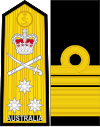
|

|

| |
| Rank title: | Admiral of the Fleet | Admiral | Vice Admiral | Rear Admiral | Commodore |
| Abbreviation: | AF | ADML | VADM | RADM | CDRE |
| NATO Code | OF-5 | OF-4 | OF-3 | OF-2 | OF-1 | OF(D) | |||||
|---|---|---|---|---|---|---|---|---|---|---|---|
| Aus/US Code | O-6 | O-5 | O-4 | O-3 | O-2 | O-1 | O-0 | ||||
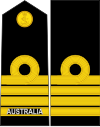
|

|

|
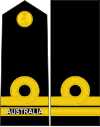
|
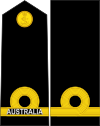
|

| ||||||
| Rank title | Captain | Commander | Lieutenant Commander | Lieutenant | Sub Lieutenant | Acting Sub Lieutenant | Midshipman | ||||
| Abbreviation | CAPT | CMDR | LCDR | LEUT | SBLT | ASLT | MIDN | ||||
Sailors
[edit]| NATO Code | OR-9* | OR-9 | OR-8 | OR-6 | OR-5 | OR-3 | OR-2 | OR-1 | |||
|---|---|---|---|---|---|---|---|---|---|---|---|
| Aus/US Code | E-9 | E-9 | E-8 | E-6 | E-5 | E-3 | E-2 | E-1 | |||

|

|

|

|

|

|

|
No insignia | ||||
| Rank Title: | Warrant Officer of the Navy | Warrant Officer | Chief Petty Officer | Petty Officer | Leading Seaman | Able Seaman | Seaman | Recruit | |||
| Abbreviation: | WO-N | WO | CPO | PO | LS | AB | SMN/SMN* | RCT | |||
Rate Insignia
[edit]
Royal Australian Navy Other Ranks wear "right arm rates" insignia, called "Category Insignia" to indicate specialty training qualifications.[44] This is a holdover from the Royal Navy.
Special insignia
[edit]The Warrant Officer of the Navy (WO-N) is an appointment held by the most senior sailor in the RAN and holds the rank of warrant officer (WO). However, the WO-N does not wear the WO rank insignia; instead, they wear the special insignia of the appointment.[45] The WO-N appointment has similar equivalent appointments in the other services, each holding the rank of warrant officer, each being the most senior sailor/soldier/airman in that service, and each wearing their own special insignia rather than their rank insignia. The Australian Army equivalent is the Regimental Sergeant Major of the Army (RSM-A)[46] and the Royal Australian Air Force equivalent is the Warrant Officer of the Air Force (WOFF-AF).[47]
Chaplains and Maritime Spiritual Wellbeing Officers
[edit]
Chaplains in the Royal Australian Navy are commissioned officers who complete the same training as other officers in the RAN at the Royal Australian Naval College, HMAS Creswell. From July 2020, Maritime Spiritual Wellbeing Officers (MSWOs) were introduced to the Navy Chaplaincy Branch, designed to give Navy people and their families with professional, non-religious pastoral care and spiritual support.[48]
In the Royal Australian Navy, Chaplains and MSWOs are commissioned officers without rank. For reasons of protocol, ceremonial occasions and for saluting purposes, they are, where appropriate, normally grouped with Commanders (O-5).[49]. The more senior Division 4 Senior Chaplains are grouped with Captains (O-6) and Division 5 Principal Chaplains are grouped with Commodores (O-7), but their rank slide remains the same. Principal Chaplains and MSWOs, however, have gold braid on the peak of their white service cap.[citation needed]
From January 2021, MSWOs and all chaplains wear the branch's new non-faith-specific rank insignia of a fouled anchor overlaying a compass rose, which represents a united team front, encompassing all faiths and purpose. Chaplains and MSWOs have insignia that reflect their religion on collar mounted patches (Cross for Christian, Crescent for Muslim etc, Compass rose for MSWOs.)[50]
Ships and equipment
[edit]Current ships
[edit]The RAN currently operates nearly 50 commissioned vessels, made up of nine ship classes and three individual ships, plus 11 non-commissioned vessels. In addition, DMS Maritime operates a large number of civilian-crewed vessels under contract to the Australian Defence Force.
| Image | Class/name | Type | Number | Entered service | Details |
|---|---|---|---|---|---|
| Commissioned vessels | |||||
 |
Collins class | Submarine | 6 | 1996 | Anti-shipping, intelligence collection. Diesel-electric powered. |
 |
Canberra class | Landing helicopter dock | 2 | 2014 | Amphibious warfare ships with aircraft carrier capacity. |
 |
Hobart class | Destroyer | 3 | 2017 | Air warfare destroyer.[51] |
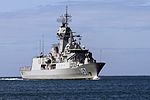 |
Anzac class | Frigate | 7 | 1996 | Anti-submarine and anti-aircraft frigate with one helicopter. Two more were built for the Royal New Zealand Navy. |
 |
Armidale class | Patrol boat | 3 | 2005 | Coastal defence, maritime border, and fishery protection. |
 |
Huon class | Minehunter | 3 | 1997 | Minehunting. Four active, two decommissioned. |
 |
Leeuwin class | Survey ship | 1 | 2000 | Hydrographic survey |
 |
Bay class | Landing ship dock | 1 | 2011 | Heavy sealift and transport |
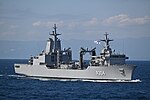 |
Supply class | Replenishment oiler | 2 | 2021 | Replenishment at sea and afloat support. |
| Non-commissioned vessels | |||||
 |
Cape class | Patrol boat | 9 | 2017 | Maritime border and fishery protection, augmenting the Armidale class. Two more under construction, with another two ordered.[52] |
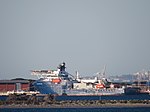 |
ADV Ocean Protector | Auxiliary | 1 | 2016 | Auxiliary vessel, manned and managed by Teekay. |
 |
ADV Guidance | Auxiliary | 1 | 2023 | Auxiliary vessel / undersea support vessel, manned and managed by Teekay. |
 |
ADV Reliant | Auxiliary | 1 | 2022 | Pacific support vessel, manned and managed by Teekay. |
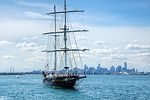 |
STS Young Endeavour I | Sail training ship | 1 | 1988 | Tall ship, operated under the Young Endeavour Youth Scheme. |
 |
MV Admiral's Barge | Ceremonial and VIP transport | 1 | 1993 | The main Admiral's Barge belonging to the VIP Boat Squadron and based at Fleet Base East. |
 |
MV Admiral Hudson | Ceremonial and VIP transport | 1 | 1995 | A Kingfisher 54 cruiser used as an admiral's barge belonging to the VIP Boat Squadron and based at Fleet Base East. |
Fleet Air Arm
[edit]| Image | Squadron | Equipment | Number | Role | Details |
|---|---|---|---|---|---|
| Operational Squadrons | |||||
 |
816 Squadron | MH-60R | 8 | Anti-submarine warfare, anti-surface warfare, search and rescue | The RAN operates 23 MH-60Rs, 8 of which are usually deployed at sea at any one time with the rest in maintenance and training.[53][54][55] One was ditched in the Philippine Sea in October 2021 while embarked on HMAS Brisbane.[55] |
 |
808 Squadron | MH-60R | Transport and resupply | In April 2022, the RAN ceased flying the MRH-90 Taipan and the fleet was placed into storage.[56][57] In May 2022, the Australian government announced that the MRH-90 would be replaced by additional MH-60R Seahawks.[58][59] In September 2022, the government ordered 12 MH-60Rs.[60][61] | |
| Training Squadrons | |||||
 |
725 Squadron | MH-60R | 15 | Conversion training and maintenance | |
 |
723 Squadron | EC-135T2+ | 15 | Helicopter aircrew training | |
| Experimental Squadron | |||||
 |
822X Squadron | ScanEagle | Unmanned aerial vehicle trials | ||
 |
S-100 Camcopter | ||||
Small arms
[edit]RAN personnel utilise the following small arms:[62]
Future
[edit]There are currently several major projects underway that will see upgrades to RAN capabilities.
- Project SEA 1180 Phase 1 is building six Arafura-class offshore patrol vessels based on the Lürssen OPV80 design, to replace Armidale-class patrol boats. Construction started in November 2018, with the first vessel, HMAS Arafura to enter service in 2022.[63][64]
- Project SEA 1905 is the acquisition of a further two Arafura-class offshore patrol vessels in a mine counter-measures configuration.[65]
- Project SEA 1654 Phase 3 acquired two Supply-class replenishment ships based on the Spanish Cantabria-class oiler. HMAS Supply was launched in November 2018[66] and replaced HMAS Success, while the second, HMAS Stalwart replaced HMAS Sirius.
- Project SEA 1445 Phase 1 is the acquisition of ten Evolved Cape class patrol boats to be built by Austal in Henderson.[67][68] The RAN decided to acquire the Evolved Cape class boats instead of extending the life of six Armidale class patrol boats as it transitions to the new Arafura class offshore patrol vessel.[69]
- Project SEA 3000 is the General Purpose Frigate program aimed to replace the Anzac-class frigates in the Tier 2 role.[70]
- Project SEA 4000 Phase 6 will upgrade the existing three Hobart-class destroyers with Aegis Baseline 9 combat system.[71]
- Project SEA 5000 Phase 1 is acquiring six Hunter-class frigates based on the British Type 26 Global Combat Ship, to replace the Anzac-class frigates in the Tier 1 ASW role from 2034. The vessels will be built in Adelaide by BAE Systems, with the first three to be named HMA Ships Hunter, Flinders and Tasman.[72]
- Surface Fleet Review announced the acquisition of six Large Optionally Crewed Surface Vessels (LOSVs) which will be constructed in partnership with the United States Navy.
Submarines
[edit]- Project SEA 1429 Phase 2 is upgrading the Collins-class submarines with the Mk48 Mod 7 CBASS torpedo.[73] Initial Operational Capability (IOC) was achieved in May 2008[73] with Final Operational Capability (FOC) due in December 2018, 60 months late.[73]
- Project SEA 1439 Phase 3 is upgrading the Collins-class submarine platform systems to improve 'reliability, sustainability, safety and capability'. IOC was achieved in October 2007, FOC is due in September 2022.[74]
- Project SEA 1439 Phase 4A is replacing the Collins-class submarines' combat system with the AN/BYG-1(V)8 developed in conjunction with the US Navy[75] IOC Expected to achieve Final Operating Capability in December 2018.[76] IOC was in May 2008 with FOC planned for December 2018.
- Project SEA 1450: In September 2021, Prime Minister Scott Morrison announced that the Collins-class submarines will receive a Life of Type Extension (LOTE) from 2026 that will cost up to A$6.4 billion.[77][78]
- SSN-AUKUS: In March 2023, Prime Minister Anthony Albanese announced that Australia will build nuclear-powered SSN-AUKUS class submarines.[79] The UK Submersible Ship Nuclear Replacement (SSNR) design was renamed SSN-AUKUS in March 2023, under the AUKUS trilateral security partnership, when Australia joined the project and additional US technology was incorporated into the design.[80][81] The construction of the first boat is to begin by the end of the 2030s with the boat delivered in the early 2040s.[82] Five boats are planned to be built.[83]
- Virginia class: In March 2023, Prime Minister Anthony Albanese announced that Australia intends to purchase three nuclear-powered Virginia class submarines from the US, subject to congressional approval, to ensure there is no capability gap as the RAN transitions to the SSN-AUKUS.[79][84] The first boat is planned to be delivered in 2033.[85] If there are delays with the SSN-AUKUS class program, Australia has the option of purchasing up to two additional Virginia class boats.[86][85]
- East coast base: In March 2022, Prime Minister Scott Morrison announced that a "new submarine base will be built on the east coast of Australia" and "three preferred locations on the east coast have been identified, being Brisbane, Newcastle, and Port Kembla".[87]
Current operations
[edit]The RAN currently has forces deployed on seven major operations:[88]
- Operation Resolute: border protection and fisheries patrol.
- Operation Manitou: counter-piracy, counterterrorism and maritime stability in the Middle East and
- Operation Accordion: support operation to provide sustainment to forces deployed on Operation Manitou.
- Operation Solania: contribute to maritime surveillance in the Pacific.
- Operation Gateway: operate maritime patrols in the Indian Ocean and South China Sea, alongside Malaysia.
- Operation Render Safe: safely dispose of remnant explosives of World War II on Pacific nations.
- Operation Dyurra: integrate space capabilities into other operations.
See also
[edit]- Australian Navy Cadets
- Australian White Ensign
- Battle and theatre honours of the Royal Australian Navy
- Royal Australian Navy Band
- Royal Australian Navy School of Underwater Medicine
- List of ships of the Royal Australian Navy
- Navy News (Australia)
References
[edit]Notes
[edit]- ^ "Current Ships". Royal Australian Navy. Archived from the original on 21 February 2022. Retrieved 1 March 2022.
- ^ "About the Royal Australian Navy". Navy (Royal Australian). Archived from the original on 1 November 2021. Retrieved 2 November 2021.
- ^ "Senior Leadership Team". Royal Australian Navy. Australian Government Department of Defence. 26 July 2018. Archived from the original on 3 January 2019. Retrieved 3 January 2019.
The Chief of Navy Australia is the most senior appointment in the Royal Australian Navy. The rank associated with the position is Vice Admiral (3-star).
- ^ "Defence Act (1903) – SECT 9 Command of Defence Force and arms of Defence Force". Australasian Legal Institute. Archived from the original on 30 November 2016. Retrieved 4 May 2021.
- ^ Dennis, Peter; Grey, Jeffrey; Morris, Ewan; Prior, Robin (2008). The Oxford Companion to Australian Military History (2nd ed.). South Melbourne, VIC: Oxford University Press. ISBN 978-0-19-551784-2. OCLC 271822831.
- ^ Greg, Swinden (14 June 2011). "Australasian Naval Forces and Commonwealth Naval Forces". Naval Historical Society of Australia. Retrieved 16 February 2024.
- ^ "Defence Act 1903". Federal Register of Legislation. 10 June 2019. Archived from the original on 22 August 2020. Retrieved 6 November 2020.
- ^ Dennis et al. 1995, p. 516.
- ^ a b Whitley 2000, p. 17.
- ^ Stevens, David. "The R.A.N. – A Brief History". Royal Australian Navy. Archived from the original on 3 December 2013. Retrieved 10 August 2013.
- ^ a b c d "Before Gallipoli – Australian Operations in 1914". Navy. Archived from the original on 13 September 2021. Retrieved 13 September 2021.
- ^ Dennis et al. 1995, p. 517.
- ^ Perryman, John; Swinden, Greg. "1st Royal Australian Naval Bridging Train". Navy. Archived from the original on 30 September 2021. Retrieved 1 October 2021.
- ^ Stevens, David. "Gallipoli as a Joint Maritime Campaign". Navy. Archived from the original on 1 October 2021. Retrieved 2 October 2021.
- ^ Gillett & Graham 1977, p. 193.
- ^ a b Gillett & Graham 1977, p. 61.
- ^ a b c d Dennis et al. 1995 p. 518.
- ^ Gillett & Graham 1977, pp. 69–76.
- ^ Gillett & Graham 1977, p. 93.
- ^ Gillett & Graham 1977, p. 94.
- ^ Dennis et al. 1995, pp. 519–520.
- ^ "Database of Royal Australian Navy Operations, 1990–2005" (PDF). Working Paper No. 18. Sea Power Centre. Archived from the original (PDF) on 27 February 2012. Retrieved 24 August 2014.
- ^ Dennis et al. 1995, pp. 607–608.
- ^ Sea Power Centre, Australia (April 2009). "The Spirit of the Navy" (PDF). Semaphore (5). Australian Government Department of Defence. Archived (PDF) from the original on 3 January 2019. Retrieved 3 January 2019.
- ^ "Navy Strategic Command". Royal Australian Navy. Australian Government Department of Defence. 6 June 2018. Archived from the original on 3 January 2019. Retrieved 3 January 2019.
Navy Strategic Command [...] is headquartered in Canberra
- ^ "Defence Organisational Structure Chart" (PDF). Australian Government Department of Defence. Commonwealth of Australia. 17 December 2018. Archived (PDF) from the original on 3 January 2019. Retrieved 3 January 2019.
- ^ C L Cumberlege Archived 3 March 2016 at the Wayback Machine
- ^ "Top Stories". Archived from the original on 10 March 2007.
- ^ Australian Maritime Doctrine. p. 124. Archived from the original on 3 December 2013. Retrieved 10 August 2013.
- ^ "Fleet Air Arm". Royal Australian Navy. Archived from the original on 30 October 2018. Retrieved 30 October 2018.
- ^ "The Fleet". Archived from the original on 16 January 2016. Retrieved 10 April 2021.
- ^ Frame 2004, p. 96.
- ^ "Fleet Base East". Royal Australian Navy. Archived from the original on 27 March 2020. Retrieved 31 August 2014.
- ^ "Fleet Base West". Royal Australian Navy. Archived from the original on 16 March 2020. Retrieved 31 August 2014.
- ^ "HMAS Cairns". Royal Australian Navy. Archived from the original on 3 April 2020. Retrieved 31 August 2014.
- ^ "HMAS Coonawarra". Royal Australian Navy. Archived from the original on 13 April 2020. Retrieved 31 August 2014.
- ^ "HMAS Waterhen". Royal Australian Navy. Archived from the original on 13 April 2020. Retrieved 31 August 2014.
- ^ a b Defence Annual Report 2022-2023 (PDF). The Australian Department of Defence. 2023. p. 95. ISBN 978-1-925890-48-8. Archived (PDF) from the original on 7 April 2024.
- ^ a b Defence Annual Report 2022-23 (PDF). The Australian Department of Defence. 2023. p. 98. ISBN 978-1-925890-48-8. Archived (PDF) from the original on 7 April 2024.
- ^ a b "Ranks of the Royal Australian Navy". Royal Australian Navy. Retrieved 26 October 2024.
- ^ "Australian Defence Force Honorary Ranks for His Majesty The King". Department of Defence (Press release). 19 October 2024. Retrieved 26 October 2024.
- ^ "Navy Training: Officer Training". Defence Jobs. Archived from the original on 3 September 2014. Retrieved 31 August 2014.
- ^ a b "Australian Defence Force Badges of Rank and Special Insignia" (PDF). Australian Defence Force. 20 October 2008. DPS: APR025/08. Retrieved 23 March 2023.
- ^ "Category Badges". Navy (dot) Gov. Royal Australian Navy. Archived from the original on 1 December 2022. Retrieved 1 December 2022.
- ^ "Defence Leaders: Navy". www.defence.gov.au. Archived from the original on 14 May 2015. Retrieved 10 August 2013.
- ^ "Regimental Sergeant Major – Army". www.army.gov.au. Archived from the original on 9 June 2012.
- ^ "Warrant Officer of the Air Force". www.airforce.gov.au. Archived from the original on 9 June 2012. Retrieved 21 June 2012.
- ^ Defence, Department of (11 May 2020). "New chaplaincy branch reflects secular care option". news.defence.gov.au. Archived from the original on 1 November 2021. Retrieved 1 November 2021.
- ^ Royal Australian Navy. "Ranks". navy.gov.au. Retrieved 1 January 2024.
... Chaplains and MSWOs are commissioned officers without rank. However, for ceremonial and protocol purposes they are, where appropriate, normally grouped with Commanders (O-5). ...
- ^ Royal Australian Navy. "Chaplains". www.navy.gov.au. Archived from the original on 1 November 2021. Retrieved 1 November 2021.
- ^ Navy, Royal Australian. "Warship Sydney commissions at sea". Navy Daily. Archived from the original on 29 October 2020. Retrieved 19 May 2020.
- ^ Staff, Naval News (4 November 2022). "Austal delivers 3rd Evolved Cape-Class Patrol Boat to RAN". Naval News. Retrieved 4 November 2022.
- ^ "MH-60R Seahawk". Royal Australian Navy. Archived from the original on 11 October 2021. Retrieved 11 October 2021.
- ^ "816 Squadron". Royal Australian Navy. Archived from the original on 21 November 2021. Retrieved 11 October 2021.
- ^ a b "Three aircrew safe after helicopter ditched in the Philippine Sea". Department of Defence (Press release). 14 October 2021. Archived from the original on 21 October 2021. Retrieved 9 January 2022.
- ^ Hurst, Daniel (9 November 2022). "Australia pays to maintain trouble-plagued Taipan helicopters no longer being used by navy". The Guardian. Retrieved 22 March 2023.
- ^ Department of Defence (2022). Portfolio Budget Statements October 2022-23 - Defence Portfolio (PDF). Canberra: Commonwealth of Australia. p. 57. ISBN 9781925890587. Retrieved 22 March 2023.
- ^ Prime Minister Scott Morrison; Minister for Defence Peter Dutton; Minister for Defence Industry, Minister for Science and Technology Melissa Price (9 May 2022). "Securing our national security and local defence jobs and skills". Liberal Party of Australia (Press release). Archived from the original on 9 May 2022. Retrieved 1 September 2022.
- ^ Department of Defence (2020). 2020 Force Structure Plan (PDF). Commonwealth of Australia. p. 37. ISBN 9780994168061. Archived (PDF) from the original on 13 April 2021. Retrieved 2 October 2021.
- ^ "Lockheed Martin to produce 12 more MH-60R Seahawk Helicopters for the Royal Australian Navy". Lockheed Martin (Press release). 20 September 2022. Retrieved 5 October 2022.
- ^ "Australia – MH-60R Multi-Mission Helicopters and related defense services". Defense Security Cooperation Agency (Press release). Transmittal No. 21-61. 8 October 2021. Archived from the original on 9 October 2021. Retrieved 11 October 2021.
- ^ "Small arms". Royal Australian Navy. Archived from the original on 25 April 2021. Retrieved 25 April 2021.
- ^ "Arafura Class OPV". Royal Australian Navy. Archived from the original on 8 November 2021. Retrieved 13 November 2021.
- ^ "Offshore Patrol Vessels". Department of Defence (Australia). Archived from the original on 29 June 2018. Retrieved 29 June 2018.
- ^ "Draft Infrastructure & Land Use Plan" (PDF). Western Australian Government. 18 June 2020. Archived (PDF) from the original on 2 July 2020. Retrieved 30 June 2020.
- ^ "RAN's next oiler ship launched in Spain". Australian Defence Magazine. 26 November 2018. Archived from the original on 13 February 2019. Retrieved 12 February 2019.
- ^ Minister for Defence Linda Reynolds; Minister for Defence Industry Melissa Price (1 May 2020). "New patrol boats to boost Navy capability". Department of Defence Ministers (Press release). Retrieved 17 September 2022.
- ^ Prime Minister Scott Morrison; Minister for Defence Peter Dutton; Minister for Defence Industry Melissa Price (18 April 2022). "Keeping our borders safe and supporting Australian industry". Liberal Party of Australia (Press release). Archived from the original on 21 May 2022.
- ^ Australian National Audit Office (2021). Department of Defence's Procurement of Six Evolved Cape Class Patrol Boats (PDF). ANAO Report No.15 2021–22. Canberra: The Auditor-General. pp. 14–15. ISBN 9781760337001. Retrieved 20 March 2023.
- ^ Arthur, Gordon (7 June 2024). "Australia fast-tracks its hunt for replacement frigates". Defense News. Retrieved 21 June 2024.
- ^ Manov, Elyse. "Hobart Class Destroyers". Defence SA. Retrieved 21 June 2024.
- ^ Wroe, David (28 June 2018). "British frigate program to seed Australia's own warship industry, Turnbull says". The Sydney Morning Herald. Archived from the original on 28 June 2018. Retrieved 28 June 2018.
- ^ a b c "ANAO Report No. 26 2017–18". Australian National Audit Office. pp. 331–338. Archived from the original on 13 February 2019. Retrieved 12 February 2019.
- ^ "Collins Class Submarine reliability and sustainability". Department of Defence (Australia). December 2017. Archived from the original on 28 January 2019. Retrieved 12 February 2019.
- ^ "Collins Class Submarine Replacement Combat System". Department of Defence Science & Technology. 2019. Archived from the original on 13 February 2019. Retrieved 12 February 2019.
- ^ "Collins Replacement Combat System". Department of Defence (Australia). February 2018. Archived from the original on 29 June 2018. Retrieved 29 June 2018.
- ^ Prime Minister; Minister for Defence; Minister for Finance (16 September 2021). "Key naval projects confirmed for South Australia". Prime Minister of Australia (Press release). Archived from the original on 16 September 2021.
- ^ "Raytheon to support Collins combat systems". Australian Defence Magazine. 12 October 2022. Retrieved 22 March 2023.
- ^ a b Prime Minister of Australia Anthony Albanese; Prime Minister of the United Kingdom Rishi Sunak; President of the United States of America Joseph R. Biden (14 March 2023). "Joint Leaders Statement on AUKUS". Prime Minister of Australia (Press release). Retrieved 14 March 2023.
 This article contains quotations from this source, which is available under a Creative Commons Attribution 4.0 International Licence.
This article contains quotations from this source, which is available under a Creative Commons Attribution 4.0 International Licence.
- ^
 This article incorporates text published under the British Open Government Licence v3.0: Ministry of Defence; Defence Nuclear Organisation (14 March 2023). "The AUKUS Nuclear Powered-Submarine Pathway: A Partnership for the Future" (PDF). pp. 7, 23. Retrieved 17 March 2023.
This article incorporates text published under the British Open Government Licence v3.0: Ministry of Defence; Defence Nuclear Organisation (14 March 2023). "The AUKUS Nuclear Powered-Submarine Pathway: A Partnership for the Future" (PDF). pp. 7, 23. Retrieved 17 March 2023.
- ^ "Design work begins on successor to Astute-class submarines in £170m deal". Royal Navy. 17 September 2021. Retrieved 19 March 2023.
- ^ Ministry of Defence 2023, pp. 7, 23.
- ^ Briggs, Peter (12 October 2023). "How many nuclear-powered submarines for Australia?". The Strategist — Australian Strategic Policy Institute. Retrieved 15 October 2023.
- ^ Ministry of Defence 2023, pp. 8.
- ^ a b Stewart, Cameron (14 March 2023). "Big gamble, but even bigger benefits in AUKUS subs". The Australian. Retrieved 17 March 2023.
- ^ Defence Minister Richard Marles; Minister for Defence Industry Pat Conroy (14 March 2023). "Press conference - Parliament House, Canberra". Department of Defence Ministers. Retrieved 16 March 2023.
- ^ Prime Minister; Minister for Defence Peter Dutton (7 March 2022). "Australia to build additional submarine base". Prime Minister of Australia (Press release). Archived from the original on 9 March 2022. Retrieved 25 September 2021.
 This article contains quotations from this source, which is available under a Creative Commons Attribution 4.0 International Licence.
This article contains quotations from this source, which is available under a Creative Commons Attribution 4.0 International Licence.
- ^ "Operations". Royal Australian Navy. Archived from the original on 17 August 2014. Retrieved 31 August 2014.
Bibliography
[edit]- Bogart, Charles H. (2006). "The Royal Australian Navy: A Pictorial Look at the 1980s". Warship International. XLIII (2): 195–221. ISSN 0043-0374.
- Dennis, Peter; Grey, Jeffrey; Morris, Ewan; Prior, Robin (1995). The Oxford Companion to Australian Military History. Melbourne: Oxford University Press. ISBN 0-19-553227-9.
- Frame, Tom (2004). No Pleasure Cruise: The Story of the Royal Australian Navy. Crows Nest, New South Wales: Allen & Unwin. ISBN 1-74114-233-4.
- Gillett, Ross; Graham, Colin (1977). Warships of Australia. Adelaide, South Australia: Rigby. ISBN 0-7270-0472-7.
- Whitley, M. J. (2000) [1988]. Destroyers of World War Two: An International Encyclopedia. London: Cassell. ISBN 1-85409-521-8.
- Department of Defence, (Australia) (2021). Defence Annual Report 2020-2021 (PDF). Defence Publishing Service. p. 117.
